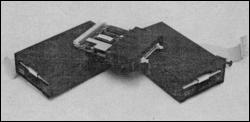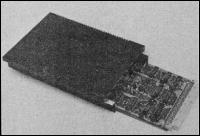| QL Hardware World |
THE MicroPeripherals QL disc interface marks a departure for the company, away from printers and into dedicated add-ons. It is also unusual in that it contains none of the Toolkit from Tony Tebby.
With the interface MicroP supplies a disc which contains a number of utilities. It can also supply QL dedicated - in other words painted black - 3½ in, 80 track, double sided, disc drives. Those give 1434 useable sectors when formatted.

Inside the interface, which has to be taken apart, are a series of jumper connectors. Normally the interface responds to the device name FDK but by connecting one of the jumpers - a connector is supplied - it can be made to respond on power up to MDV. In that way programs on microdrive can be transferred to the disc without alteration and will still run.
The instructions - those supplied with the review model were marked Preliminary - are brief but adequate. One criticism might be that the first thing the instructions tell you to do is to format a disc. As the only disc supplied contains the utilities that could be disastrous. A note of warning would be appropriate.
In operation the disc drives accept the same commands and, perform in the same way as microdrives. In addition the interface supplies four new commands. FSET and MSET perform the same function as the jumper mentioned above, MSET gives the disc drives the name MDV, and FSET, FDK. The other two, DGET and DPUT, allow you to assign a sector, not the directory, on the disc to an array and then write it back. This addition allows for simple disc editing.
The utilities disc contains nine programs, six of them multitasking routines. Those allow you to make backups of a disc; perform a string replacement on a disc file; obtain an extended directory, including the file length, and easily delete files; inspect a file on screen; and spool a file to 'another device - that is, you could print a file while running another program.
The other three programs are DAME, a disc and memory editor which allows you to alter a disc or memory easily; Colprint, a screen dump program for colour printers; and repos_bas, a window defining program.
All programs are supplied on a 3½in disc. With an 80 track, double-sided, 5¼in drive connected as drive one the system becomes rather temperamental. It will not reliably write to and read from it. It can read the directory of a CST disc, and in some cases load a program from it, but not one of its own discs.
The price of the system, £113.85, makes it the cheapest available so far and as such it is worth consideration. However, added to that is the need to use the MicroP drives, £194.35 for the first drive and £171.35 for the second. Those are reasonable prices but 3½in discs are almost twice the price of 5¼ which adds to the cost.
MicroPeripherals Ltd, Hampshire.
QUEST, who was one of the first companies to announce QL hardware, has released four RAM boards ranging from 64K up to the full 512K.
When extra RAM is fitted to the QL it performs two functions. It is used as both additional buffer space for the microdrives, which makes access times quicker, and for the program data. In addition it allows programs to run much faster than normal.

That is due to the design of the internal hardware. Every 50th of a second the ULA in the QL takes charge of the bottom memory and uses the screen area to send the picture to the TV. The CPU cannot access this memory at the same time and has to sit, twiddling its thumbs, until the ULA has finished with the memory.
If you fit additional memory, over and above the standard 128K, the CPU can access it while the ULA is dealing with the picture and so it is not slowed down. The increase in speed can be as high as 50 percent.
As a bonus a cartridge is supplied with a program which allows you to use some of this memory as a RAM disc; this works as though it were a normal disc drive but, being in memory, access times are faster.
RAM discs normally use the device name RDV but this can be changed to be MDV. This makes it possible to run the version 1.00 Psion programs on them; version 2.00 can be configured to use any name.
The increase in speed of the Psion programs, which can be run from a RAM disc plus the added space for data, transforms them into very professional pieces of software. The only problem with this extra memory space is that with a large amount of data it cannot all be stored on one microdrive cartridge.
While extra memory can be very useful the RAM disc, facility is somewhat limited. The process to use them on, for example Quill, would be: 1 - load RAM disc software; 2 - format RAM disc; 3 - copy Quill to RAM disc; 4 - run Quill; 5 - copy data file from RAM disc back to microdrive.
All four upgrades - 64K £115, 128K £185, 256K £349 and 512K £579 - are more expensive than others available.
For further details, contact Quest Automation, Hampshire.